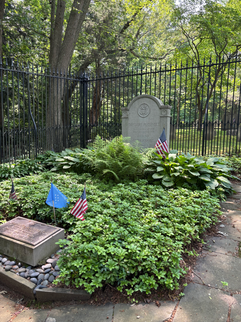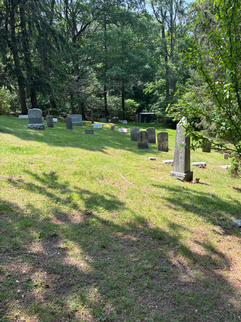important burials
- Shellie Taylor
- Jul 7
- 5 min read

If you read by last blog post, you'll know that I recently went on a trip to Long Island, New York for the wedding of a good friend from college. I had my bestie pick me up from the BWI airport in Maryland and then went on a road trip which took us through Philadelphia, New Jersey, and of course, New York. I had been to Long Island dozens of times over the years, mostly visiting said friend who got married. Despite the frequency of my visits and how many times I had traveled into the city from there, I knew very little about the rich history of the island and its role in state history.
While we were staying on Long Island, we decided to visit the historic site of Sagamore Hill, which was the home of President Theodore Roosevelt and now features a presidential museum, pet cemetery that I posted about in Instagram, and a nature trail that takes you out to the water. Even though it was hot as Hades when we were there, it was an undeniably beautiful place.

After visiting the museum, Teddy Roosevelt quickly rose in my top presidents list. I already knew he was the Father of our National Parks, but I didn't know all the details of the extent to which he made that initiative come to life. Roosevelt was what we would call an "accidental" president. After serving two years as governor of New York, he was elected as Vice President under William McKinley in 1900. When McKinley was assassinated in 1901, Roosevelt assumed the presidency. He already had the reputation of a war hero for his leadership role with the Rough Riders during the Spanish-American War in 1898. He brought bad press on the government at the time by highlighting the poor conditions that the soldiers had to experience. He was posthumously awarded the Medal of Honor during the presidency of Bill Clinton in 2001 for his service.
As president he succeeded in several efforts to bring about prosperity for the people and to keep them safe. In 1906 he was instrumental in negotiating with Congress over what would become the Pure Food and Drug Act which led to the establishment of the Food and Drug Administration. I wrote a post a while back about infant mortality and the contribution of poor health and milkborne illnesses to those rates. Roosevelt's presidency was at the heart of the reformation that took place and turned the tide on unnecessary deaths due to unsafe food.


Of course, Teddy Roosevelt's greatest accomplishment during his time in office was his efforts to protect our natural resources and the land that makes America so unique. There were plans for development and railroad companies to demolish sections of the Grand Canyon in the name of expansion and growth. Roosevelt put a stop to that and made that area of Arizona protected. Using executive orders like no president before him, he is responsible for saving 230 million acres of land which include 150 national forests, the first 55 wildlife refuges and bird sanctuaries, and the first 18 national monument sites.
There is no doubt that the legacy of Theodore Roosevelt is a big one and as a nature lover alone I am indebted to his work in protecting the beauty of all living things around us. The Roosevelt family purchased the property in the 1880s from the Youngs family who had owned the land since 1654. To think that only two families owned this portion of Long Island throughout history is pretty incredible. Across the road from the entrance to Sagamore Hill, the Youngs Memorial Cemetery sits on a hill, the top of which at one time had a magnificent view of Oyster Bay. This is where the former president and his wife are buried. Many other generations of Roosevelts also rest in this cemetery.
I titled this post "important burials," and at this point you're probably assuming that the final resting place of our 26th president is the important burial I'm referring to. In fact, it is not the only important burial at Youngs Cemetery. The first burials in this cemetery took place in 1658 according to the bronze sign that greets visitors at the entrance.

I did some quick research into slavery in the northern states for this post. Being in North Carolina now and raised in Maryland, I am more familiar with slavery in the south, so this was something I was interested in learning about. I was very pleased to see that the enslaved people who were buried in this cemetery were respected and memorialized. While most slave-owning families buried their workers separate from the white family (this was true in the north as well as the south), the Youngs chose to bury their slaves within the boundaries of what had been set aside as the family burial land. Fieldstones and white wooden crosses (no doubt replaced over time) are all that marks these incredibly important people.
According to the website dedicated to the Theodore Roosevelt Gravesite, slavery was more prominent in the state of New York than all the other New England states combined. Specifically, Long Island had the largest concentration of slaves (40% of the state total). These numbers are reflective of the years in which the institution of slavery was legal in New York which was 1626-1827.
In a beautiful and moving tribute to those who lived without freedom on the Young homestead, researchers have uncovered the names of a few of the enslaved within the pages of documents in the Youngs family papers dated between 1751 and 1822. Anyone who knows my involvement in the Green Street Cemetery in Statesville will know that the most important part of the project for me was producing a list of names for all known burials. When a grave is unmarked, or simply marked with a stone or cross, there is nothing that tells us who is buried beneath the earth. Historical documents can provide the names of 18 individuals who served the Youngs family and are most likely buried within its borders.
Those believed to be buried here are Betty (or Bett), Charity, Charles Youngs, Dinah, Hannah, Harriot, James (or Jim), Jeff, Jem, Jenny, Jonah, Margaret, Mary, Pline, Sue, Tamer, Tom, and Willis.
To me, these people are as important as Teddy Roosevelt.

Slave burials are hard to find, nearly impossible to prove, and vanishing from our landscape fast. That's the mantra I go by when researching these precious burials sites. Reminding everyone that my tagline is "every burial is a story," I was elated to learn tidbits about the lives of these people. According to church records, Betty and Dinah were baptized in 1758. Pline, Hannah, Willis, and Tom did much of the shopping and delivering for the Youngs family and their names are in several business ledgers. Charity, Tamer, and Margaret were granted manumission (freedom under certain stipulations) in the early 1800s.
Visually, this cemetery is beautiful, but sentimentally, it's one of my favorites. I've only seen one other family cemetery that memorialized the enslaved who worked for the family. I wish it was more common, but when I find it, I celebrate it. I celebrate those who came before us. I celebrate my ability to make a difference today by telling the stories that need to be heard.
Thank you for reading. Thank you for caring.


























Comments